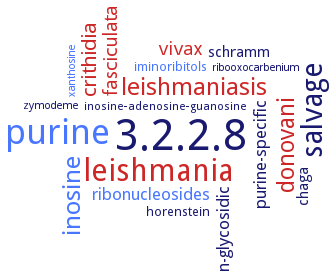3.2.2.8: ribosylpyrimidine nucleosidase
This is an abbreviated version!
For detailed information about ribosylpyrimidine nucleosidase, go to the full flat file.

Word Map on EC 3.2.2.8 
-
3.2.2.8
-
purine
-
leishmania
-
salvage
-
inosine
-
leishmaniasis
-
donovani
-
crithidia
-
fasciculata
-
vivax
-
purine-specific
-
n-glycosidic
-
ribonucleosides
-
schramm
-
chaga
-
horenstein
-
iminoribitols
-
inosine-adenosine-guanosine
-
ribooxocarbenium
-
xanthosine
-
zymodeme
- 3.2.2.8
- purine
- leishmania
-
salvage
- inosine
- leishmaniasis
- donovani
- crithidia
- fasciculata
- vivax
-
purine-specific
-
n-glycosidic
- ribonucleosides
-
schramm
-
chaga
-
horenstein
- iminoribitols
-
inosine-adenosine-guanosine
-
ribooxocarbenium
- xanthosine
-
zymodeme
Reaction
Synonyms
CU-NH, cytidine-uridine nucleoside hydrolase, cytidine-uridine-preferring nucleoside hydrolase, LBRM_18_1610, More, N-ribohydrolase, N-ribosylpyrimidine nucleosidase, N-ribosylpyrimidine ribohydrolase, NH, NSH1, nucleosidase, pyrimidine, nucleoside hydrolase, pyrimidine nucleosidase, pyrimidine nucleoside hydrolase, pyrimidine-specific nucleoside hydrolase, ribonucleoside hydrolase 1, rih1, RihA, RihB, SsCU-NH, SSO0505, URH1, uridine-ribohydrolase 1, YbeK, YeiK
ECTree
Advanced search results
Crystallization
Crystallization on EC 3.2.2.8 - ribosylpyrimidine nucleosidase
Please wait a moment until all data is loaded. This message will disappear when all data is loaded.
hanging drop vapour diffusion method, using 100 mM Tris (pH 8.5), 200 mM NaCl, and 24% PEG 4000
molecular dynamics simulation. Both in wild-type and mutant T223Y/Q227Y, inosine binding is facilitated by interactions of the ribose moiety with active site residues and Ca2+, and pi-interactions between residues His82 and His239 and the nucleobase. The lack of observed activity toward inosine for wild-type CU-NH is explained by no residue being correctly aligned to stabilize the departing nucleobase. A hydrogen-bonding network between hypoxanthine and a general acid Asp15 is present when the two Tyr mutations are engineered into the active site. This hydrogen-bonding network is only maintained when both Tyr mutations are present due to a pi-interaction between the residues
QM/MM simulations. The relatively stronger hydrogen-bond interactions between uridine and the active-site residues Gln227 and Tyr231 play an important role in enhancing the substrate binding and thus promoting the N-glycosidic bond cleavage, in comparison with inosine. The estimated energy barrier is 30 kcal/mol for the hydrolysis of inosine and 22 kcal/mol for uridine. The uridine binding is exothermic by about 23 kcal/mol, and inosine binding by 12 kcal/mol
RihA bound to inhibitor 3,4-diaminophenyl-D-iminoribitol, hanging drop vapour diffusion method, 8 mg/ml RihA in 50 mM HEPES, pH 7.2, 150 mM NaCl is mixed with a 5:1 molar excess of 3,4-diaminophenyl-D-iminoribitol, solubilized in 50 mM HEPES, pH 7.2, and incubated at 4°C for 3 hours, the protein/inhibitor complex is mixed with an equal volume of a precipitant solution containing 25% PEG 4000, 0.1 M sodium acetate, pH 5.0, X-ray diffraction structure determination and analysis at 2.1 A resolution, molecular replacement
-
purified detagged recombinant enzyme, hanging drop vapour diffusion method, 10 mg/ml protein in 20 mM HEPES, pH 7.4, 150 mM NaCl, is mixed with precipitant solution, 25°C, equilibration versus reservoir solution containing 100 mM Tris-HCl, pH 8.5, 200 mM NaCl, 25% w/v PEG 3350, cryoprotection by 25% glycerol, X-ray diffraction structure determination and analysis at 1.7 A resolution
-
purified recombinant enzyme in complex with D-ribose, hanging drop vapour diffusion method, 10 mg/ml protein in 10 mM Tris, pH 7.0, 25 mM NaCl, and 500 mM D-ribose, is mixed with an equal volume of precipitant solution containing 24% 2-methyl-2,4-pentanediol, 0.1 M sodium acetate, pH 5.0, and 500 mM D-ribose, 20°C, 1 week, X-ray diffraction structure determination and analysis at 1.78 A resolution
crystal structure is determined at 1.6 A resolution. The enzyme is crystallized using the hanging drop vapor diffusion method by mixing an equal amount of protein and a precipitant solution, composed of 100 mM bicine (pH 9) and 1.5 M ammonium sulfate


 results (
results ( results (
results ( top
top





